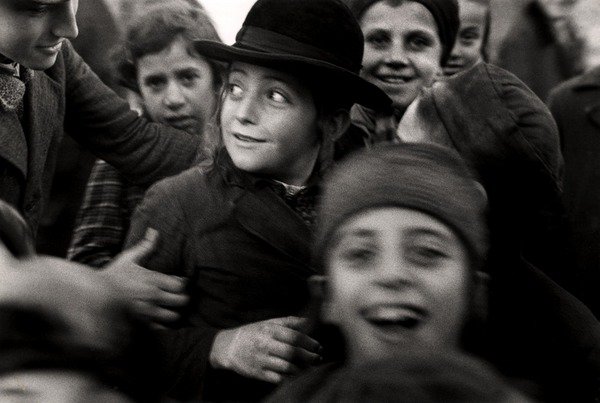Roman Vishniac Rediscovered
dal 16/1/2013 al 4/5/2013
Segnalato da
International Center of Photography
16/1/2013
Roman Vishniac Rediscovered
International Center of Photography ICP, New York
The exhibition includes recently discovered vintage prints, moving film footage, personal correspondence, and exhibition prints made from Vishniac's recently digitized negatives.

Curated by Maya Benton
Roman Vishniac Rediscovered, on view at the International Center of Photography (1133 Avenue of the
Americas at 43rd Street) January 18–May 5, 2013, brings together four decades of work by a remarkably
versatile and innovative photographer. The exhibition includes recently discovered vintage prints, moving film
footage, personal correspondence, and exhibition prints made from Vishniac’s recently digitized negatives.
His complex and visionary work, much of which is shown here for the first time, reveals a compositional
acuity, inventiveness, and surprising stylistic range that solidifies his place among the 20th century’s most
accomplished photographers.
Vishniac created the most widely recognized and reproduced photographic record of Jewish life in Eastern
Europe between the two World Wars. Yet only a fraction of his work was published during his lifetime, most
notably in A Vanished World (1983). Over the course of his career, Vishniac witnessed the sweeping artistic
and photographic innovation of Weimar Berlin, the ominous rise to Nazi power in Germany, the final years of
Jewish life in Eastern Europe, and immigrant life in America during and after the war.
“By repositioning Vishniac’s iconic photographs of Eastern Europe within the broader tradition of social
documentary photography, and introducing recently discovered and radically diverse bodies of work,
this exhibition stakes Vishniac’s claim as a modern master,” said ICP Adjunct Curator Maya Benton, who
organized the exhibition.
Born in 1897 to a wealthy Russian-Jewish family, Vishniac immigrated to Berlin in 1920 in the aftermath of
the Russian Revolution. As an amateur photographer, he took to the streets with his camera throughout the
1920s and ’30s, offering astute, often humorous visual commentary on his adopted city and experimented
with new and modern approaches to framing and composition.
Documenting the rise of Nazi power, he
focused his lens on the signs of oppression and doom that soon formed the backdrop of his Berlin street
photography. From 1935 to 1938, while living in Berlin and working as a biologist and science photographer,
he was commissioned by the American Jewish Joint Distribution Committee (JDC), then the world’s largest
Jewish relief organization, to photograph impoverished Jewish communities in Central and Eastern Europe.
On New Year’s Day, 1941, he arrived in New York and soon opened a portrait studio. At the same time, he
began documenting American Jewish communal and immigrant life and established himself as a pioneer
in the field of photomicroscopy. In 1947, Vishniac returned to Europe and documented Jewish displaced
persons camps and the ruins of Berlin. During this time, he also recorded the efforts of Holocaust survivors
to rebuild their lives, and the work of the JDC and other Jewish relief organizations in providing them with aid
and emigration assistance.
Roman Vishniac Rediscovered is a comprehensive reappraisal of Vishniac’s total photographic output, from
the early years in Berlin through the postwar period. The exhibition also includes a slideshow of 100 color
science transparencies—digitized for the first time—of Vishniac’s microphotoscopy, taken from the early
1950s to the late 1970s. In addition to the exhibition, a primary task of the archive is to make this work
available for research, in partnership with the United States Holocaust Memorial Museum.
This exhibition is made possible with support from Mara Vishniac Kohn, whose generosity founded the
Roman Vishniac Archive at ICP, and from the Andrew and Marina Lewin Family Foundation, Estanne and
Martin Fawer, The David Berg Foundation, Righteous Persons Foundation, National Endowment for the Arts,
Olitsky Family Foundation, the ICP Exhibitions Committee, James and Merryl Tisch, Koret Foundation, Caryl
and Israel Englander, Taube Foundation for Jewish Life and Culture of the Jewish Community Endowment
Fund, Tamar and Eric Goldstein, Laura and Murray Huberfeld, additional anonymous donors, and by public
funds from the New York City Department of Cultural Affairs in partnership with the City Council. We also
acknowledge the continued collaboration of our partner, the United States Holocaust Memorial Museum,
with whom we are developing a shared digital database of the Vishniac holdings at ICP.
About ICP
The International Center of Photography (ICP) is the world’s leading institution dedicated to the practice and
understanding of photography and the reproduced image in all its forms. Through our exhibitions, educational
programs, and community outreach, we offer an open forum for dialogue about the role images play in our
culture. Since our founding, we have presented more than 500 exhibitions and offered thousands of classes,
providing instruction at every level. ICP is a center where photographers and artists, students and scholars
can create and interpret the world of the image within our comprehensive educational facilities and archive.
Opening: January 17, 2013 11:30 am–1:30 pm
International Center of Photography ICP
1133 Avenue of the Americas, 43rd St., New York
Hours
Tuesday–Thursday: 10 am–6pm
Friday: 10 am–8 pm
Saturday–Sunday: 10 am–6 pm
Closed: Mondays
Admission
General Admission: $14
Students and Seniors (with valid ID): $10
ICP Members: Free
Children under 12: Free
Voluntary Contribution Fridays 5–8 pm



